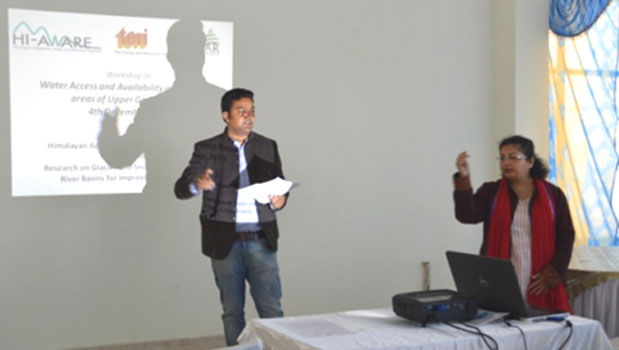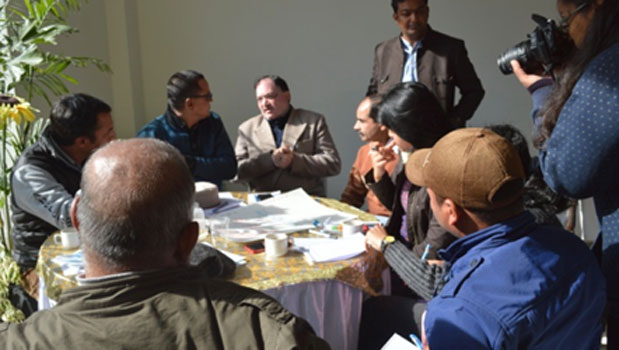 TERI presentation in progress
TERI presentation in progress
Photo by CEDAR
On 4 December 2015, The Energy and Resources Institute (TERI) and Centre for Ecology Development and Research (CEDAR) conducted a workshop on Water Access and Availability in Mountain Areas of the Upper Ganga Basin in New Tehri, Tehri Garhwal (Uttarakhand, India). The workshop was organised as part of the HI-AWARE ‘Research on Glacier and Snowpack Dependent River Basins for Improving Livelihoods in the Hindu Kush Himalayan (HKH) Region’ initiative.
The focus of the workshop was on understanding the underlying issues related to water access and its availability for domestic and irrigation purposes in the mid-hills of the Upper Ganga catchment, as well as on identifying response actions that address these issues in the context of climate change. Workshop participants included academicians, civil society/NGO practitioners, activists and government officials, all of whom presented their respective views on the subject.
 A breakout group discussion ongoing
A breakout group discussion ongoing
Photo by CEDAR
The day’s events began with keynote speaker Ms. Suruchi Bhandwal providing an introduction to the HI-AWARE research initiative. Ms. Bhandwal also presented a brief background of climate change-related issues that have been identified in the Hindu Kush Himalayan region. The workshop itself was divided into three sessions. In the first of these, speakers Dr. Soukhin Tarafdar, Scientist at the GB Pant Institute of Himalayan Environment and Development, and Mr. Shri Jagat Singh Chaudhary, a noted Uttarakhand environmentalist, presented their respective scientific and grassroots views on water access and availability.
The second session consisted of a participatory exercise in which the workshop attendees were divided into two groups, one consisting of academicians and government officials, and the other of activists and civil society practitioners. The groups were asked to identify the drivers and pressures as well as the state of water resources in the mountain areas of the Upper Ganga basin, and then to assess the impacts of the same on local communities with the aid of a problem tree diagram. Unplanned development, and the lack of and poor implementation of hill-centric development policies were two major issues whose causes and impacts were discussed by participants from both groups. The groups also considered various means of addressing these issues including advanced methods of drip irrigation and rainwater harvesting. Participants also discussed the Chaal, khaal model—a traditional water harvesting structure, and made a reference to the mixed forestry model presented by Mr. Chaudhary in the first session.
The third and final session of the workshop began post lunch with the stakeholders choosing one response action and then identifying its associated actors. The relationships and linkages between the actors were also identified through a network mapping process. This network mapping helped participants visualise important linkages such as the flow of information, funds and commands. Each actor was then rated on a scale of 0-5 so as to surmise their respective importance, power and responsibility in the context of the chosen response option. As an outcome of the exercise, workshop participants were able to identify institutions such as NABARD and the World Bank as important funding agencies, and the Uttarakhand Jal Nigam as an important planning and implementation government agency. The need for an ‘Integrated Mountain Policy’ which would encompass all related sectors and view relevant issues inter-connectedly was also identified. It was concluded that integrated policies on water-agriculture-forests instead of specific policies on each, for example, would be more effective.
Towards the end of the workshop, the two groups shared the outcomes of the exercises they’d participated in throughout the day with each other. These presentations were followed by open group discussions in which these outcomes were further analysed. The workshop recognised the need for research institutions to be given their due importance as it concluded that research institutes must be made essential parts of decision-making processes that are related to water access and availability in mountain regions. Special emphasis was given to the need for better a coordination of efforts between different departments and institutions working in the area of water availability and access. It was concluded that the outcomes of such coordinated efforts must be consolidated and stored in a central repository that will be accessible to all stakeholders.
